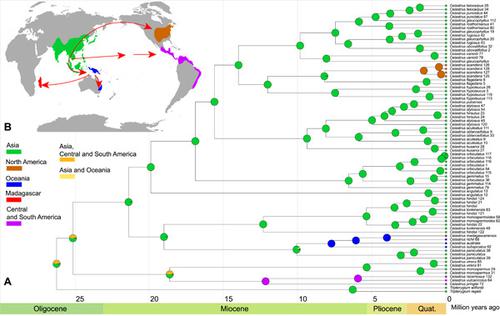当前位置:
X-MOL 学术
›
J. Syst. Evol.
›
论文详情
Our official English website, www.x-mol.net, welcomes your
feedback! (Note: you will need to create a separate account there.)
Animal‐mediated long‐distance dispersals and migrations shaping the intercontinental disjunctions of Celastrus (Celastraceae) among five continents
Journal of Systematics and Evolution ( IF 3.4 ) Pub Date : 2020-09-07 , DOI: 10.1111/jse.12661 Yi‐Xuan Zhu 1 , Feng‐Wei Lei 1 , Ling Tong 1 , Xian‐Yun Mu 1, 2 , Jun Wen 2 , Zhi‐Xiang Zhang 1
Journal of Systematics and Evolution ( IF 3.4 ) Pub Date : 2020-09-07 , DOI: 10.1111/jse.12661 Yi‐Xuan Zhu 1 , Feng‐Wei Lei 1 , Ling Tong 1 , Xian‐Yun Mu 1, 2 , Jun Wen 2 , Zhi‐Xiang Zhang 1
Affiliation

|
The mechanisms underlying the origin, evolution, and distributional patterns of organisms are a major focus of biogeography. Vicariance and long‐distance dispersal (LDD) are two important explanations for disjunctive distribution patterns among lineages. In‐depth biogeographic studies of taxa that exhibit wide‐ranging disjunctions can provide valuable information for addressing the relative importance of these biogeographic mechanisms. The genus Celastrus contains ca. 30 species that are disjunctly distributed in five continents of both the Northern and Southern Hemispheres, providing an excellent system for historical biogeographic analyses. Here, we used sequence data from five markers (nuclear external transcribed spacer and internal transcribed spacer, and plastid psbA‐trnH, rpl16, and trnL‐F) to reconstruct the phylogeny of Celastrus and investigate its phylogenetic relationships with Tripterygium, estimate clade divergence times using the fossil‐calibrated method, and infer its ancestral distribution range. Celastrus and Tripterygium were each supported as monophyletic. The morphology‐based classification systems were not supported by the phylogenetic results. The divergence time between Celastrus and Tripterygium was estimated to be 26.22 Ma (95% highest posterior density: 24.46–28.17 Ma), and the diversification of Celastrus were suggested to be linked to global warming events during the Miocene. Celastrus was suggested to have a tropical Asian origin, and dispersed to Central and South America, North America, Oceania, and Madagascar at different periods, most probably through LDD. Birds may have facilitated transoceanic migrations of Celastrus because of its bicolored fruits, which contain red and fleshy arils. Our results highlight the importance of key morphological innovations and animal‐mediated dispersals for the rapid diversification of plant lineages across vast distributional ranges.
中文翻译:

动物介导的长距离传播和迁徙塑造了五大洲之间 Celastrus (Celastraceae) 的洲际分离
生物的起源、进化和分布模式背后的机制是生物地理学的主要焦点。Vicariance 和长距离扩散 (LDD) 是谱系间分离分布模式的两个重要解释。对表现出广泛分离的分类群进行深入的生物地理学研究可以为解决这些生物地理学机制的相对重要性提供有价值的信息。Celastrus 属包含约。30 个物种间断地分布在北半球和南半球的五大洲,为历史生物地理分析提供了一个极好的系统。在这里,我们使用了来自五个标记(核外部转录间隔区和内部转录间隔区,以及质体 psbA-trnH、rpl16、和 trnL-F) 重建 Celastrus 的系统发育并研究其与雷公藤的系统发育关系,使用化石校准方法估计进化枝发散时间,并推断其祖先分布范围。Celastrus 和雷公藤各自被支持为单系。系统发育结果不支持基于形态的分类系统。Celastrus 和雷公藤之间的分化时间估计为 26.22 Ma(95% 的最高后密度:24.46-28.17 Ma),并且认为 Celastrus 的多样化与中新世期间的全球变暖事件有关。Celastrus 被认为起源于热带亚洲,并在不同时期分散到中美洲和南美洲、北美洲、大洋洲和马达加斯加,最有可能是通过 LDD。鸟类可能促进了 Celastrus 的越洋迁徙,因为它的双色果实含有红色和肉质的假种皮。我们的研究结果强调了关键形态创新和动物介导的传播对于跨越广阔分布范围的植物谱系快速多样化的重要性。
更新日期:2020-09-07
中文翻译:

动物介导的长距离传播和迁徙塑造了五大洲之间 Celastrus (Celastraceae) 的洲际分离
生物的起源、进化和分布模式背后的机制是生物地理学的主要焦点。Vicariance 和长距离扩散 (LDD) 是谱系间分离分布模式的两个重要解释。对表现出广泛分离的分类群进行深入的生物地理学研究可以为解决这些生物地理学机制的相对重要性提供有价值的信息。Celastrus 属包含约。30 个物种间断地分布在北半球和南半球的五大洲,为历史生物地理分析提供了一个极好的系统。在这里,我们使用了来自五个标记(核外部转录间隔区和内部转录间隔区,以及质体 psbA-trnH、rpl16、和 trnL-F) 重建 Celastrus 的系统发育并研究其与雷公藤的系统发育关系,使用化石校准方法估计进化枝发散时间,并推断其祖先分布范围。Celastrus 和雷公藤各自被支持为单系。系统发育结果不支持基于形态的分类系统。Celastrus 和雷公藤之间的分化时间估计为 26.22 Ma(95% 的最高后密度:24.46-28.17 Ma),并且认为 Celastrus 的多样化与中新世期间的全球变暖事件有关。Celastrus 被认为起源于热带亚洲,并在不同时期分散到中美洲和南美洲、北美洲、大洋洲和马达加斯加,最有可能是通过 LDD。鸟类可能促进了 Celastrus 的越洋迁徙,因为它的双色果实含有红色和肉质的假种皮。我们的研究结果强调了关键形态创新和动物介导的传播对于跨越广阔分布范围的植物谱系快速多样化的重要性。











































 京公网安备 11010802027423号
京公网安备 11010802027423号